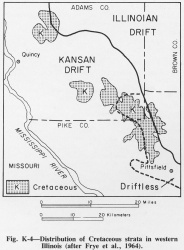Baylis Formation
Lithostratigraphy: Embayment Megagroup >>Baylis Formation
Chronostratigraphy: Mesozoic Erathem >>Cretaceous System >>Gulfian Series
Primary source
Willman, H. B., Elwood Atherton, T. C. Buschbach, Charles Collinson, John C. Frye, M. E. Hopkins, Jerry A. Lineback, and Jack A. Simon, 1975, Handbook of Illinois Stratigraphy: Illinois State Geological Survey Bulletin 95, 261 p.
Contributing author(s)
H. B. Willman and John C. Frye
Name
Original description
The Baylis Formation (Frye et al., 1964, p. 4).
Derivation
Named for Baylis, Pike County.
Other names
History/background
Type section
Type location
Baylis is 4 miles north of the type section, which is an exposure and small pit along a branch of Kiser Creek (NW SW SE 31, 4S-4W).
Type author(s)
Type status
Reference section
Reference location
Reference author(s)
Reference status
Stratigraphic relationships
The Baylis Formation comprises all the sediments of Cretaceous age in western Illinois. The Baylis rests unconformably on Mississippian and Pennsylvanian rocks and is overlain unconformably by Pleistocene deposits, generally only loess in the main ridge northwest of Pittsfield but elsewhere by Kansan drift and, locally, by Illinoian drift (fig. K-4).
Extent and thickness
The Baylis occurs in Pike and Adams Counties in a prominent ridge that extends for about 20 miles northwest of the Pittsfield area, and it also appears 10 miles farther northwest in a smaller, less prominent area south of Mendon in Adams County (fig. K-4). The Baylis has a maximum thickness of about 100 feet near Baylis, but the top of the formation is eroded and it may originally have been much thicker.
Lithology
The Baylis is largely fine to medium quartz sand and clayey sand. In places it contains lenses of silty clay and pebbles of chert, quartz, and quartzite. The basal few feet is generally gravel and is differentiated as the Hadley Gravel Member. The upper, sandy part of the formation is the Kiser Creek Member. The sands are generally white, but in places some beds are stained brown by limonite. The basal part of the gravel is locally strongly cemented with iron and manganese minerals, although most of the formation is uncemented and soft.
Core(s)
Photograph(s)
Contacts
Well log characteristics
Fossils
Age and correlation
Most of the formation is similar in lithology to the Cretaceous Dakota Formation in west-central Iowa, but the Hadley Gravel Member closely resembles the Windrow Formation in Iowa and Wisconsin (Andrews, 1958).
Environments of deposition
Economic importance
Remarks
References
ANDREWS, G. W., 1958, Windrow Formation of Upper Mississippi Valley region: Journal of Geology, v. 66, p. 597-624.
FRYE, J. C., H. B. WILLMAN, and H. D. GLASS, 1964, Cretaceous deposits and the Illinoian glacial boundary in western Illinois: Illinois State Geological Survey Circular 364, 28 p.
ISGS Codes
| Stratigraphic Code | Geo Unit Designation |
|---|---|
